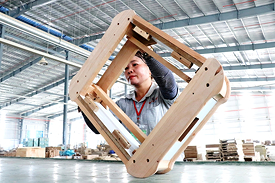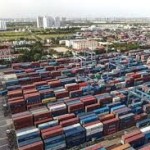Total number of posts 435.
 Vietnam is one of the world’s largest exporters of timber and timber products. It has become a vastly important part of the country’s economy. But what challenges are the country experiencing, and how can it leverage the timber industry to enhance economic growth?
Vietnam is one of the world’s largest exporters of timber and timber products. It has become a vastly important part of the country’s economy. But what challenges are the country experiencing, and how can it leverage the timber industry to enhance economic growth?
Vietnam’s forestry sector exports contributed US$12.5 billion to the country’s economy in 2020, according to Viet Nam News, despite the impact of the pandemic. This marked a sizable increase from 2019 when Vietnam’s timber exports were valued at US$10.3 billion. The increase is reflective of the industry’s growing importance to the Vietnamese economy. Producers are typically split into three groups: state-owned, private companies (international or local), and smallholders. The industry supports as many as 500,000 jobs.
Vietnam is among the largest exporters, globally, of wood pellets, veneer sheets, and recovered paper, according to United Nations data. In fact, Vietnam exported around 3.2 million tons of pellets in 2020, making it the world’s second-largest exporter of the product. These pellets were mostly exported to Japan and South Korea to be used as fuel for thermal power production.
Production of pellets has increased significantly from 175 tons in 2013 to 3.2 million tons in 2020. This reflects Vietnam’s move to enhance timber processing capacity, which in turn increases the value-added to the economy. According to Timber Trade Portal, only around 30 percent of timber-related exports were the raw material itself. This is also reflective of the country’s development as an international manufacturing powerhouse. Vietnam is also a considerable importer of hardwood. Imports add to the domestic mix and are used in manufacturing, particularly in the furniture industry.
What are the challenges facing Vietnam’s timber industry?
Vietnam has around14.6 million hectares (ha) of forested land, accounting for a staggering 41.65 percent of the country’s total land mass. Approximately 10.2 million ha are primary or otherwise naturally regenerated forests, while 4.1 million ha are planted forests. The current level of forest cover represents a considerable increase from 1993 when forested areas only accounted for 28 percent of the country’s land area. Vietnam’s forest cover had decreased considerably between 1943 and 1993.
Vietnam adopts a centralized approach to managing its forested areas, with the government and National Assembly responsible for all laws governing the sector. The government has imposed a partial logging ban on all-natural forests in the country since 1993, which is partially responsible for the country’s increasing forest cover. The policy aims to reduce forest degradation and the destruction of natural ecosystems. However, illegal logging is still a major issue. Despite the regulation, there was a lack of monitoring, poor case handling, and few incentives for local authorities to address the issue.
In fact, the quality of Vietnam’s forests has continued to deteriorate since 1993. Firstly, the increase in forest cover over the past three decades is partially due to the growth of plantations – plantations do not provide the same high-quality ecosystem as natural forests. This is reflected by the forest reference emission levels submitted to the
United Nations Framework Convention on Climate Change in 2016. It was estimated that over two-thirds of Vietnam’s forests are in poor condition or regenerating. Rich, closed-canopy forests only represent five percent of the total forested area. There’s also competition for forested land in Vietnam. Coffee plantations might represent the biggest risk factor that could trigger further deforestation. In previous decades, rubber plantations had been responsible for the destruction of natural forests.
It’s also worth noting that Vietnam’s attempts to clean up its supply chain have not had the desired effect. In 2018, the country signed an agreement with the European Union (EU) to reform its timber sector and, in return, boost access to the heavily regulated EU markets. However, measures introduced in 2020 to curb illegal timber products in the supply chain have not led to a decrease in imports of high-risk timber. The term refers to products from countries where there are high levels of deforestation. Demand for imported hardwood rose in 2016 when the government introduced a blanket ban on all logging in the country’s natural forests. Vietnam’s supply chain issues could jeopardize its access to lucrative export markets, such as the EU and US.
These challenges are reflective of the forestry sector’s struggle to attract investment. There is a general perception that the timber industry is not overly profitable or may be negatively impacted by regulatory changes. Because of a dearth of investment, Vietnam’s producers are struggling to meet domestic demand for timber. This is compounded by the fact that around a quarter of the country’s forests are managed by smallholders. Not only do they lack the money to invest, but their subsistence lifestyle often compels them to cut down their timber before it has reached a stage where it can be used in furniture production or for other high-quality wood products. Forest communities are among the poorest in Vietnam.
Increasing the economic value of Vietnam’s timber industry
Vietnam needs to enhance the legitimacy of its operations in order to secure more lucrative trade deals, including getting a firm foothold in the US furniture market, according to the Chairman of the Vietnam Timber & Forest Products Association (VIFORES) Do Xuan Lap. Amid a trade war between the US and China, Vietnam has emerged as an alternative supplier of wood products. The US is already the main destination market for the exports of wood products.
However, legitimacy is also an issue if Vietnamese producers wish to gain greater access to other high-value overseas markets. The US, Canada, UK, and EU all have highly regulated markets. Continued imports from high-risk locations, such as Cameroon, Gabon, Laos, and Cambodia, and supply agreements with Chinese logging companies operating in Africa, may jeopardize market access.
The continued formalization of the timber industry will be an important step. Vietnam needs to move away from a situation in which subsistence forest communities are forced to harvest trees early in order to sustain themselves. For one, yields are higher when the timber remains planted for longer. But secondly, timber that is harvested too early cannot be used by furniture manufacturers. One option is that the government could assist by filling the liquidity gap and providing grants or low-interest loans to assist smallholders throughout the timber’s lifecycle. The state could facilitate this or guarantee agreements with furniture manufacturers to ensure the timber reaches maturity and that the smallholders don’t run short of funds.
In 2018, the International Union for the Conservation of Nature (IUCN), highlighted further areas where Vietnam’s timber industry could be enhanced. It noted the need to improve technical capacity at the sub-national level to ensure the availability of high-quality native seedlings. It also recommended the improvement of infrastructure links to ensure timber products can be easily transported to manufacturers. The IUCN also suggested that the state could play more of a role in providing training and education opportunities to smallholders.
As large businesses and manufacturers prefer not to deal with lots of small suppliers, there could also be a role for the government in creating a supplier body that brings together smaller producers. This could further assist with the formalization of parts of the industry and provide a platform to assist smallholders with grants and loans. Vietnam has already explored group certification for smallholders and the trial reportedly yielded significant benefits. Smallholders often struggle to cover recurring costs for certification, even if the costs are subsidized by bilateral donors, as was the case for the group certification project.
The sector’s resilience could also be enhanced by diversifying plantations. A movement away from the country’s genetically identical acacia monocultures would reduce the risk of disease outbreaks that could wipe out Vietnam’s timber stock. Native species are also in demand by the domestic furniture sector. Some furniture manufacturers are already working with smallholders to create rotation timber plantations that meet Forest Stewardship Council certification levels.
Regional competition
Indonesia is also one of the world’s largest exporters of tropical timber products. Like Vietnam, timber is often exported as a wide variety of timber products, ranging from plywood, pulp, and paper to furniture and handicrafts. According to the FLEGT Independent Market Monitor, the top three export destinations for Indonesian timber in the last year were China, the US, and Japan. However, in 2020, Indonesia attempted to relax laws that stipulated Indonesian timber companies need to obtain export licenses that certify the wood origin from legal sources. Although, it has been reported that 11th-hour changes to the bill have restricted its scope and impact. Relaxations of such laws would likely impact market access.
Meanwhile, Malaysia is also a timber-producing nation that exports hardwood to Vietnam. The countries recently signed a Memorandum of Cooperation to further develop the timber trades in both countries. The Malaysian Timber Council (MTC) said that the country was committed to further developing its timber industry sustainably and would benefit from the advanced state of Vietnam’s furniture manufacturing sector and its access to the EU market. Malaysia has around 183,000 ha of plantations.
Source: ASEAN Briefing














